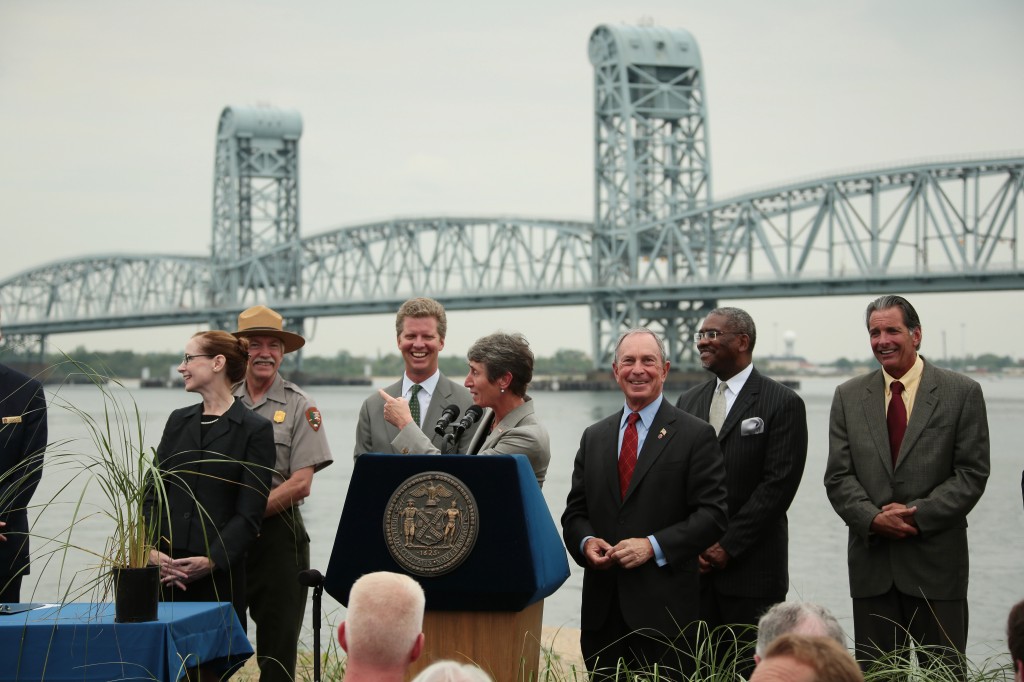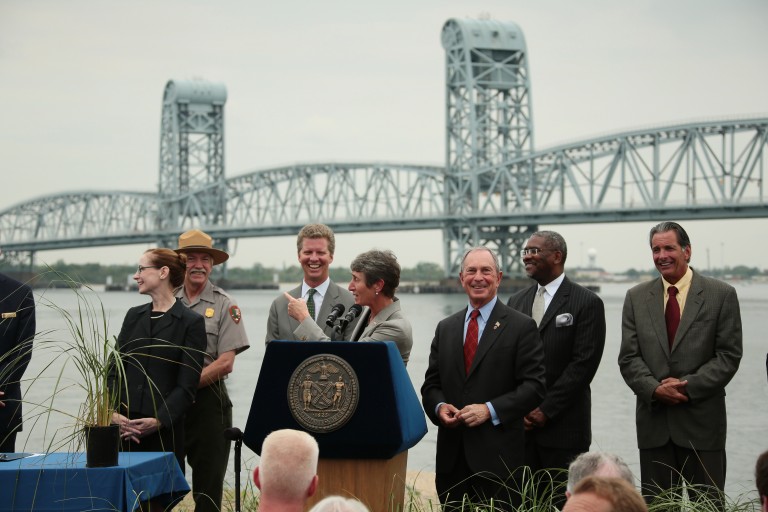
Mayor Bloomberg, third from right, and U.S. Interior Secretary Sally Jewell center at podium, and other officials announce the creation of the Jamaica Bay Science and Resilience Institute at a press conference in Rockaway this week. Photo Courtesy Edward Reed/Mayor Bloomberg’s Office
Jamaica Bay is becoming a testing ground for how to best mitigate the effects of storms and rising sea levels, Mayor Bloomberg and U.S. Secretary of the Interior Sally Jewell announced in the Rockaways this week.
Bloomberg, Jewell and a host of other city, state and federal officials said at a press conference at Riis Landing on Monday that the newly created Jamaica Bay Science and Resilience Institute will be home to an ambitious team of scientists from the City University of New York, as well as other leading scholars, who will int1egrate research from across the natural and social sciences and draw upon the studies of climate science, engineering and sustainability to create a program to revitalize and restore Jamaica Bay – a 10,000-acre nature preserve straddling Queens and Brooklyn.
“Jamaica Bay is one of the greatest natural treasures any city has within its borders, and our administration is working hard to make the bay an even greater, stronger, and more resilient natural resource for decades to come,” Bloomberg said of the preserve that is co-managed by the city and the federal government. “The new consortium we’re announcing today is an all-star team of research institutions and non-profits who will do important work to protect and preserve urban ecosystems from development and from the effects of climate change.”
The institute, which will kick off its work with a conference on climate change on Oct. 17 and 18, will research urban ecosystems, including such topics as sand dune engineering and oyster farming to mitigate flooding. Officials said the lessons learned at Jamaica Bay could then be replicated across the country.
“In the city of New York, we have a powerful and dedicated partner to promote visitation, education programs, scientific research and opportunities for recreation in our urban parks,” Jewell said. “And now, in CUNY and their academic partners, we have a consortium of world-class institutions to advance our understanding of climate change and its impact on our natural systems. Working together we will develop and coordinate approaches to coastal resiliency for Jamaica Bay that can serve as a model for communities around the world threatened by climate change.”
U.S. Housing and Urban Development Secretary Shaun Donovan agreed, saying the research at Jamaica Bay will help to prepare communities “for impacts of climate change and help them build in a way that makes them stronger, more economically competitive and better able to withstand future storms.”
In addition to the research center, Bloomberg also announced the formation of the Jamaica Bay-Rockaway Parks Conservancy, a public-private partnership that will raise funds for the planning and development of the Jamaica Bay area.
The mayor and Jewell added that there are plans to create a beach grass nursery at Floyd Bennett Field in Jamaica Bay. This pilot program, using funds raised by the Jamaica Bay-Rockaway Parks Conservancy, will collect native seeds from the bay and Rockaway and create a nursery to grow beach grass in an effort to restore city coastline.
By Anna Gustafson

